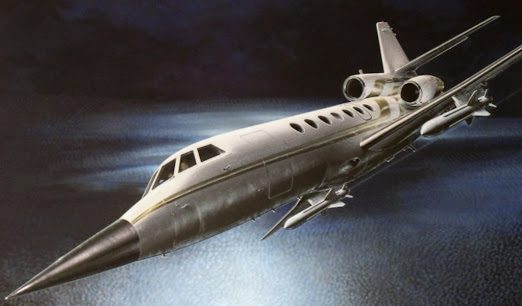Ad Code
Bitcoin
6/Bitcoin/post-list
Weekly
Aircraft
6/Aircraft/post-list
NFT
6/NFT/post-list
Dassault Falcon 50 'Suzanna' – Business Jet in USS Stark Incident, Capable of Launching Two AM-39 Exocet Anti-Ship Missiles
Richards
6:32 AM
Table of Contents [Show]
Read Also:
In theory, a business jet could be armed, however, in fact it is not easy to integrate a type of weapon, say an anti-ship cruise missile into a business jet. Huge costs are needed for modifications, system testing, certification to regulation to make this happen. And one of the business jets that can carve 'golden ink' by being an anti-ship missile launcher, is the French-made Dassault Falcon 50.
The Falcon 50, produced by Dassault Aviation, is a type of business jet with a triple jet engine that was popular in the 80s and 90s. The debut of the Falcon 50 as a missile launcher was when this business jet operated by the Iraqi Air Force was involved as an executor in an attack on the USS Navy frigate USS Stark on May 17, 1987 in the Persian Gulf.
The USS Stark incident is an unpleasant experience that befell the US Navy in the modern era. USS Stark was unexpectedly disabled by two AM-39 Exocet anti-ship missiles which were initially reported to have been launched by two Mirage F1EQ-5 fighter jets belonging to the Iraqi Air Force. As a result of the Exocet attack incident, 37 US Navy personnel were killed and 21 others were injured. -wound.
USS Stark is part of the Middle East Task Force assigned to patrol off the coast of Saudi Arabia near the Iran-Iraq border. At that time, United States Central Command identified the attack aircraft as an Iraqi Dassault Mirage F1 fighter.
However, the actual reports confirmed that the attack aircraft was a Dassault Falcon 50 business jet that had been modified with a radar and missile hardpoints to carry two AM-39 Exocet missiles for anti-ship operations. The attack by the Falcon 50 was clearly not expected by the crew of USS Stark, given that identification on radar classified the Falcon 50 as a civilian aircraft.
Meanwhile, the Mirage F1EQ-5 operated by Iraq at that time was only able to carry one Exocet unit in one flight. Iraq has previously used a modified Falcon jet with civilian markings to conduct covert photographic intelligence and reconnaissance operations in the Persian Gulf to avert suspicion.
Iraq, which was not in confrontation with the US, later said that the incident was a shooting error. Iraqi military authorities thought that the USS Stark was an Iranian tanker that entered Iraqi exclusive waters. Through negotiations, it was finally agreed that Iraq would provide US$27.3 million in compensation for the families of the victims of the USS Stark incident.
Mods On Falcon 50
Apart from the controversy over the facts that occurred in the USS Stark incident, what is interesting to pick up here is Dassault Aviation's ability to modify its business jets into deadly fighters.
By Dassault Aviation, the Falcon 50 is fitted with a Mirage F.1 pointed nose model containing a Cyrano radar — and one launcher for AM-39 Exocet anti-ship missiles under each wing. Throughout 1985 and early 1986, the Director of the Intelligence Department of the Iraqi Air Force, Brigadier General Mudher al-Farhan, gathered intelligence on the work of Iranian tankers-shuttles operated by specially trained crews and escorted by warships of the Iranian Navy.
Later, the Iraqi Intelligence Service provided one of the Dassault Falcon 50 jets for clandestine operations whose purpose was to 'visually inspect' some future targets.
The study results proposed fitting the same Cyrano IV-C5 radar and Mirage F.1EQ-5 fire control system to the Falcon 50. Modification work was carried out in France. As a result of related negotiations, Falcon 50 with registration YI-ALE was delivered to France. During the modifications at Villaroche, the Iraqi Falcon 50 retained the usual controls on the left side of the cockpit but received the full cockpit from the F.1EQ-5 on the right.
The external changes were even more dramatic, the original nose was replaced and received the Mirage F.1's distinctive pointed nose which contained the Cyrano radar. And the weapons package, in the form of the ability to launch two AM-39 Exocet anti-ship missile units.
After extensive testing in France, the Falcon 50 was flown to Iraq on 9 February 1987 and assigned to Iraqi Air Force service. By the Baghdad Intelligence Service, the plane was known by its code name, "Suzanna".
After a series of training flights, on the morning of 17 May 1987, Suzanna's crew received orders to load two Exocet and then transfer to Wanda Air Base for operations in the Persian Gulf.
By that time, the Exocet missile had become a well-known and effective anti-ship missile, used by many nations and integrated into various air and surface platforms, including combat aircraft, helicopters and ships.
The use of the AM-30 Exocet missile from a Falcon business jet demonstrates the missile's flexibility to be transported by different platforms, including civil aircraft which can be modified for military purposes. While uncommon, this case demonstrates that under certain circumstances, the Exocet missile could be integrated into certain business jets for military purposes.
The executioner who is famous as an alumnus of the Malvinas War, AM-39 Exocet, has a weight of 670 kg with a length of 4.69 meters, a diameter of 350 mm, travels at subsonic speed and flies sea skimming, AM-39 has a range of 70 km.
Ratings:
Platform:
Monthly
Ethereum
6/Ethereum/post-list
Warships
6/Warships/post-list
Cryptocurrency
3/Cryptocurrency/post-list
Banking
3/Banking/post-list
Popular Posts
Footer Menu Widget
Copyright ©
Escort Wide | Digital Media and Cryptocurrencies










0 Comments